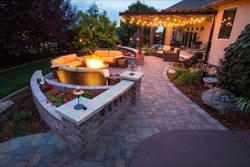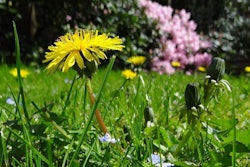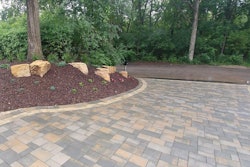Florals in spring aren’t exactly groundbreaking, but if your clients are looking for something new to plant in the landscape, there is a wealth of fantastic foliage they can also consider.
Often overlooked as merely the backdrop for the blooms of the season, foliage can offer a soothing respite of green or a pop of unexpected color in a neglected area.
“Nice foliage is pretty without being overwhelming,” said Jane Beggs-Joles, a landscape program manager with Proven Winners. “A wall of flowers is fun, but I know that I’d go into visual overload if that was all I saw in the landscape. Foliage invites us to relax and enjoy the view. Plus, there’s no deadheading!”
Since clients are increasingly interested in low-maintenance gardens, foliage can step in to provide vibrancy in the garden without as much high-maintenance needs as some flowers require.
“Pretty flowers are always going to have appeal, but I think that the low maintenance of colorful foliage is a pretty easy sell,” Beggs-Joles said. “Many clients want to hear that their yard will look great all season without a lot of work and if colorful foliage does the job, great.”
What’s popular
While what is going to be popular in your particular region will vary some, Monrovia says that stripes, spots, dots and dashes is one of its top trends for 2018 foliage, noting a 500+ percent increase in colorful foliage pins on Pinterest.
“Coral bells, Sun Stripe Lily of the Nile, hostas such as ‘Patriot’, Cream De Mint Dwarf Mock Orange, painted ferns, brunnera, Triostar Stromanthe, nandina, Voodoo and Angelia stonecrops, Camouflage Variegated Japanese Aralia and anything variegated are super popular,” said Kate Karam, editorial director for Monrovia. “The list is endless.”
Nicholas Staddon, a plantsman with Village Nurseries agrees that variegated foliage will be popular this year.
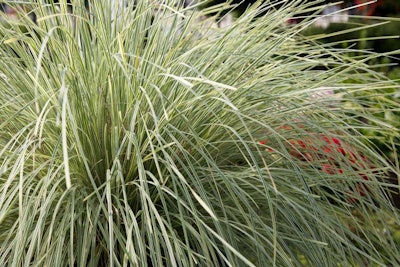 Platinum Beauty is the first green and white striped variegated form of Lomandra.
Platinum Beauty is the first green and white striped variegated form of Lomandra.Photo: Sunset Western Garden Collection
“The reason is that in the last three or four years there’s been some nice introductions of variegated plants,” he said. “For instance, the Platinum Beauty; it’s a really handsome grass-like plant. There’s no reversion. It’s clean-looking plant. It’s very functional and it has a variegation that is soft on the eye. So many variegations in the past, I think, have been gaudy, maybe even slightly outrageous.”
Staddon says that for most people, they either like variegated plants or they don’t. He attributes this to the frustration that occurs when a plant with great variegation reverts to its original colors after six months. Yet as breeders work on eliminating this issue, he says consumers are more open to this type of foliage.
“I think variegated foliage used to be sort of trendy and I think it kind of is still a bit trendy, but I think it’s like vegetable gardens used to be very hip and very trendy,” Staddon said. “Now they’re part of a cultural shift. People are more accepting of variegated foliage. They find it a bit more exciting. They find it a bit more dramatic.”
Staddon says there is still a big focus on grasses, with both green and dark varieties of mondo grass remaining popular. However, he notes people have also started gravitating toward other plants that are grass-like, such as sedges.
“I think one of the reasons this is happening, certainly in our part of the world, is gardens are getting much smaller, so a lot of today’s grasses they’re looking for are these smaller sedges,” Staddon said.
Meanwhile, cordylines, namely Anthony Tesselaar’s Festival series of cordylines, also have a grass-like appearance and are available in luscious shades of lime, raspberry and burgundy.
“Plants like that have been on the market for a few years but they’re really beginning to take off,” Staddon said.
Proven Winners says its Spilled Wine weigela, Wine & Roses weigela and the Jazz Hands Loropetalum, which all have a similar color profile, will be in high demand this year from consumers.
Beggs-Joles says many landscapers will be looking for more sustainable alternatives to traditional landscape staples.
“We’re getting a lot of requests for Kodiak Diervilla as a replacement for burning bush,” Beggs- Joles said. “Boxwood is also facing some challenges right now; Gem Box Ilex glabra, which is a good replacement for it, is really in high demand.”
Staddon believes the Lomandra variety Platinum Beauty will be particularly popular among landscapers.
“They’re used in dappled shade positions or they’re used in full sun,” Staddon said. “They’re used as a container plant. They’re used for erosion control, but this particular plant, if you said what’s the plant in your part of the world that’s going to be in the highest demand, I think this is going to be one of them. It performs well, is easy to grow, low water usage once established. I think that’s going to be a real good one for us.”
What’s new
You can’t go wrong with old standbys, but if your clients are looking for something fresh and unique, below are some of the new plants that will be hitting the market this year.
From Ball Horticultural, there is the new begonia variety called Canary Wings.
“It’s a lower-growing begonia,” Staddon said. “It has a chartreuse colored leaf supported by these wonderful orange flowers. It tends to be a lower grower but more spreading so for a shaded area, a dappled shaded area or a container, this is a fantastic plant.”
Another foliage plant on the market Staddon has noticed is the Ruby Falls redbud, which features purple-burgundy colored leaves that cascade.
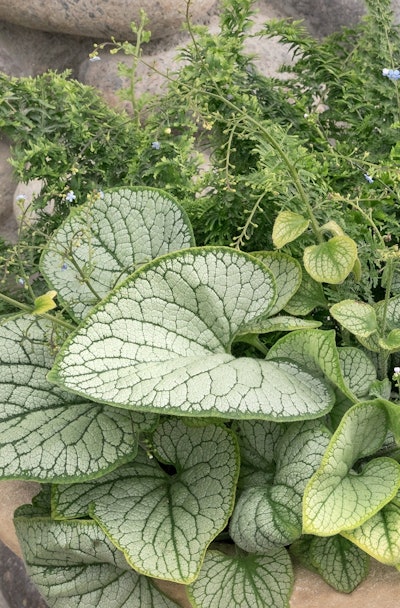 Silver Heart is one of the new variegated foliage plants on the market this year.
Silver Heart is one of the new variegated foliage plants on the market this year.Photo: Monrovia
“It’s those types of foliage that I think are really going turn people’s heads, plus you’re able to use a plant that might have been too big for a garden in a much smaller area now because it’s a cascading variety,” he said.
Some of the varieties Houzz suggests trying out include Laced Up Elderberry, which is a columnar cultivar of black elderberry. It also acknowledges the variegated trend with plants such as Morning Dew stachyurus, a plant with cream-edged pointed leaves, and Silver Charm largeleaf brunnera that has silvery-green foliage.
“Double Play Candy Corn is available in good numbers for the first time this year, and people can’t get enough of it,” Beggs-Joles said. “It’s a bold, flashy plant that adds a lot of easy color to landscapes. Low Scape Mound Aronia is also hitting the market this year. It’s a fall foliage star, but has nice spring flowers, too.”
Color craze
While most foliage is some shade of green, it is certainly not limited to this and Monrovia says it has seen lots of interest in yellow and golden foliage as of late.
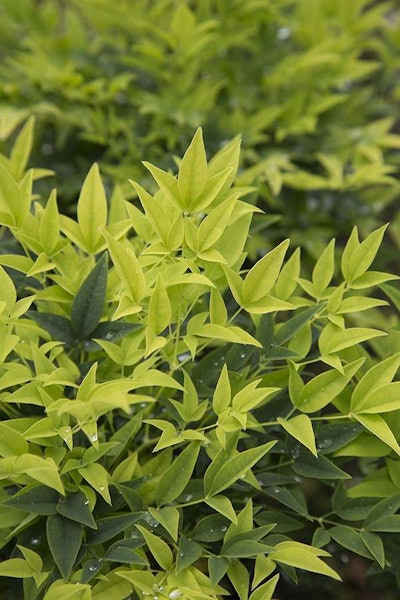 Lemon Lime nandina is an example of the chartreuse color that is expected to be popular this year.
Lemon Lime nandina is an example of the chartreuse color that is expected to be popular this year.Photo: Sunset Western Garden Collection
The color Staddon says to watch for is chartreuse, which can be found in plants like Canary Wings, or Sunset Western Garden Collection’s Lemon Lime nandina.
“There’s some regionality to color, in that some places can’t get enough yellow foliage but others like the more subdued blue-green tones,” Beggs-Joles said.
Staddon advises landscapers to pay attention to Pantone’s Color of the Year, as they can incorporate this color into the properties of customers who like to be trendy and fashionable. 2018’s Color of the Year is Ultra Violet.
“These colors of passion are really coming back,” Staddon said. “There’s a salvia called ‘Ultra Violet.’ There’s two or three salvias with that color and I think they tie very well into the Pantone Color of the Year.”
Beggs-Joles is less certain that the color Ultra Violet will take over foliage any time soon but says regular purple has been popular for years.
Why foliage
As for why customers should consider adding foliage to their garden, there are plenty of reasons, but the main fact is it is a key element to a well-balanced landscape.
“There will always be a learning curve about how magical foliage can be in the landscape and why a garden without it never looks quite ‘right,’” Karam said.
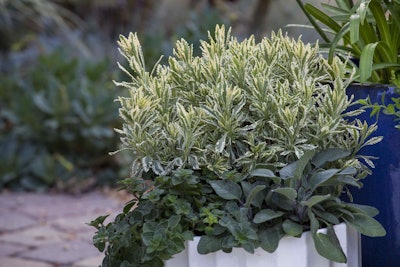 Lavender ‘Meerlo’ is an example of a plant that offers both eye-catching variegated foliage and an exquisite fragrance.
Lavender ‘Meerlo’ is an example of a plant that offers both eye-catching variegated foliage and an exquisite fragrance.Photo: Sunset Western Garden Collection
Part of the appeal of foliage is how it can create a wow factor through three of the five senses with its look, texture and fragrance.
“When designing smaller, more intimate spaces, looking beyond color to texture really opens up a lot of possibilities,” Beggs-Joles said. “Many designers already value finely cut foliage but are just now really taking advantage of plants with glossy foliage like All that Glitters Viburnnum. The play of light on shiny leaves is really intriguing.
Staddon says it’s important for the landscape designer to have a firm grasp on the client’s expectation for the use of the area.
“A lot of these foliage type plants you’ve really got to be pretty close to them to appreciate their beauty,” Staddon said. “If they’re 100 yards away or 50 feet away, you really don’t appreciate them unless they’re something that’s big and tall and covered with flowers. I think the closer you can get the client to the foliage-type plants, I think that’s a job well done.”
One of the ways he says landscapers can take advantage of foliage is to use a yellow or chartreuse colored plant and place it somewhere in the garden where people don’t ordinarily go.
“I think the job the landscape architect or designer or landscape professional has is they have got to create excitement in the garden and ideally with foliage plants,” Staddon said. “Say you put something with yellow foliage. It could be dramatic, and in turn, people will migrate back there because they’re like ‘What is that plant? I need to go look at that. With foliage, whether it’s indoors or outdoors, I think we’re on the precipice of opportunity.”


